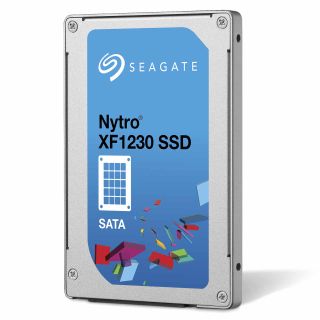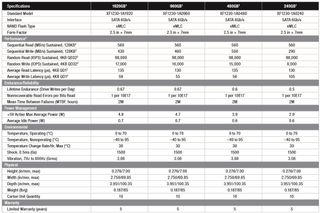Seagate Turns To SK Hynix, Rolls New Nytro XF1230 SATA SSDs
Seagate rolled out its new line of SATA HDDs for enterprise applications, and although 6 Gbps SATA SSDs aren't particularly exciting (we saturated the throughput of the interface long ago), they are the big "volume play" for SSDs vendors, so a successful strategy is critical.
Seagate's real SSD progress began when it inked a broad strategic alliance with Micron, which gives it direct access to Micron NAND and establishes an engineering partnership between the two companies. This alliance seems to be working well, as the two companies have both announced several new, jointly-designed products. Even with the alliance in place, Seagate considers its lack of a fab as a strength ("fab independence") because it isn't beholden to one flash supplier. This means the company is free to shop around for the best price and the best product, which can vary from generation to generation.

As such, the Seagate/Micron relationship took an odd turn with the new Seagate Nytro XF1230, as it features SK Hynix controllers and planar eMLC NAND. Seagate used LAMD controllers and SK Hynix NAND with its previous-generation 600 Series SSDs, which debuted way back in 2013, but the company eventually discontinued them. In the interim, SK Hynix purchased LAMD, an SSD controller vendor, and now uses the controllers internally, so this is a familiar pairing for the new Seagate SATA products.
| Header Cell - Column 0 | Seagate Nytro XF1230 | SK Hynix SE3010 | Samsung PM863 | SanDisk CloudSpeed Eco II | Intel DC S3500 | Micron M510DC |
|---|---|---|---|---|---|---|
| Capacity | 1.92TB, 960, 480, 240GB | 960GB | 3.84, 1.92 TB, 960, 480, 240, 120 GB | 1.92TB, 960, 480 GB | 80 - 800 GB | 120, 240, 480, 800, 960 GB |
| NAND | SK Hynix eMLC | 16nm SK Hynix MLC NAND | Samsung 32-layer 3D TLC V-NAND | SanDisk 15nm MLC | IMFT 20nm MLC | Micron 16nm MLC |
| Random Read/Write IOPS (up to) | 98 / 17 K | 98 / 18 K | 99 / 18 K | 76 / 14 K | 75 / 11 K | 63 / 30 K |
| Sequential Read/Write MB/s (up to) | 560 / 500 | 520 / 460 | 540 / 480 | 530 / 460 | 500 / 450 | 420 / 380 |
| Endurance (DWPD) | 0.5 - 0.67 | 0.3 - 0.6 | 1.3 | 1 | 0.35 | 1-2 |
The XF1230 isn't going to break any records with its (up to) 98,000/17,000 read/write IOPS, but it nails the high capacity points with a 1.92 TB offering. Seagate designed the SSD low power operation (2.9W-4.8W) in read-centric environments, such as boot drives, web server applications, analytics and reporting. The Nytro SATA SSDs offer up to 0.67 DWPD (Drive Writes Per Day) of endurance, which exposes it to a wide range of competing products.
The SSD comes with all of the enterprise trimmings we have come to expect, such as power loss protection, end-to-end data path protection, a two million-hour MTBF and a five-year warranty. The SSD doesn't offer encryption features, but most value-centric applications do not require the extra functionality.
Seagate has been busy refreshing its SSD portfolio, but by and large, it hasn't made as many successful moves on the SSD chessboard as its chief rival WD, which is now armed with a fab and tremendous amount of flash IP. Seagate has made a few faltering steps in the right direction, such as purchasing the once-popular SandForce SSD controller manufacturer and the Nytro line of PCIe SSDs from Avago. Surprisingly, this marks yet another non-SandForce SSD from Seagate, so one has to wonder if the brand will ever surface in retail again.
The strategic alliance provides it with more options, but it is apparent from the move that the Micron relationship isn't exclusive. The Nytro XF1230 SSDs will ship to Seagate's channel partners next month.
Stay on the Cutting Edge
Join the experts who read Tom's Hardware for the inside track on enthusiast PC tech news — and have for over 25 years. We'll send breaking news and in-depth reviews of CPUs, GPUs, AI, maker hardware and more straight to your inbox.


Paul Alcorn is the Managing Editor: News and Emerging Tech for Tom's Hardware US. He also writes news and reviews on CPUs, storage, and enterprise hardware.
-
takeshi7 The table at the top of the article says the XF1230 can do sequential writes up to 430 MB/s, but the table at the bottom shows the 480GB version can do 500MB/s.Reply -
PaulAlcorn Reply18390288 said:The table at the top of the article says the XF1230 can do sequential writes up to 430 MB/s, but the table at the bottom shows the 480GB version can do 500MB/s.
Good catch, thanks!
-
PC-Cobbler The author scooped the competition by revealing that SK Hynix is the NAND supplier, but he omitted the lithography of the NAND. As can be seen in the user manual, the process is 16 nm. Curiously, the data sheet does not contain this information. Too bad Seagate didn't use SK Hynix's 20 nm eMLC NAND, but perhaps that's out-of-production. http://www.seagate.com/enterprise-storage/solid-state-drives/nytro-xf1230-sata-ssd/#specsReply -
PaulAlcorn Reply18394604 said:The author scooped the competition by revealing that SK Hynix is the NAND supplier, but he omitted the lithography of the NAND. As can be seen in the user manual, the process is 16 nm. Curiously, the data sheet does not contain this information. Too bad Seagate didn't use SK Hynix's 20 nm eMLC NAND, but perhaps that's out-of-production. http://www.seagate.com/enterprise-storage/solid-state-drives/nytro-xf1230-sata-ssd/#specs
SK Hynix 16nm is pretty legit, from what I hear, but I'm surprised Seagate isn't using the SK Hynix 3D we took a look at earlier this year. I expect Seagate to transition to the 3D V2 in fairly short order, though. http://www.tomsitpro.com/articles/sk-hynix-pe3110-enterprise-m.2-ssd-3d-nand-v2,2-1042.html
Also, good find on the manual, it either wasn't there, or my eyes deceived me. I see that Seagate is spec'ing QoS now, as well, which means it is now an industry standard metric, pretty much.
Most Popular



